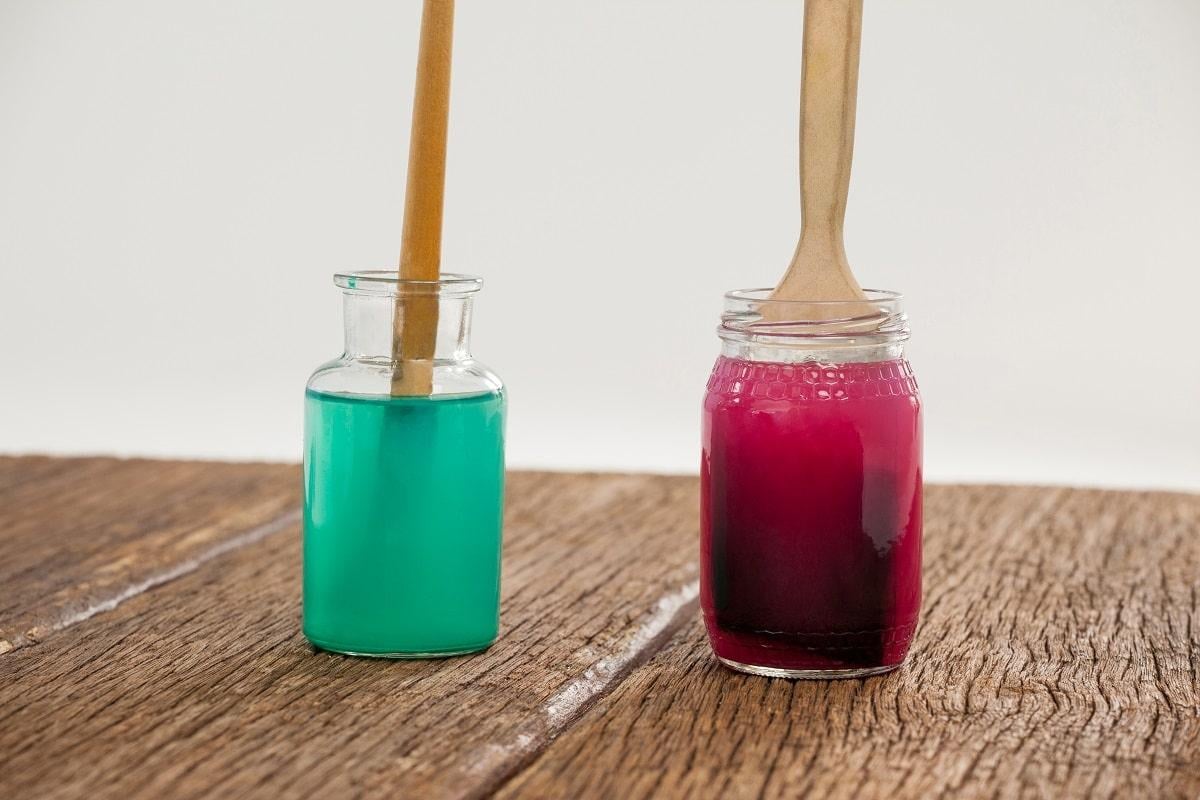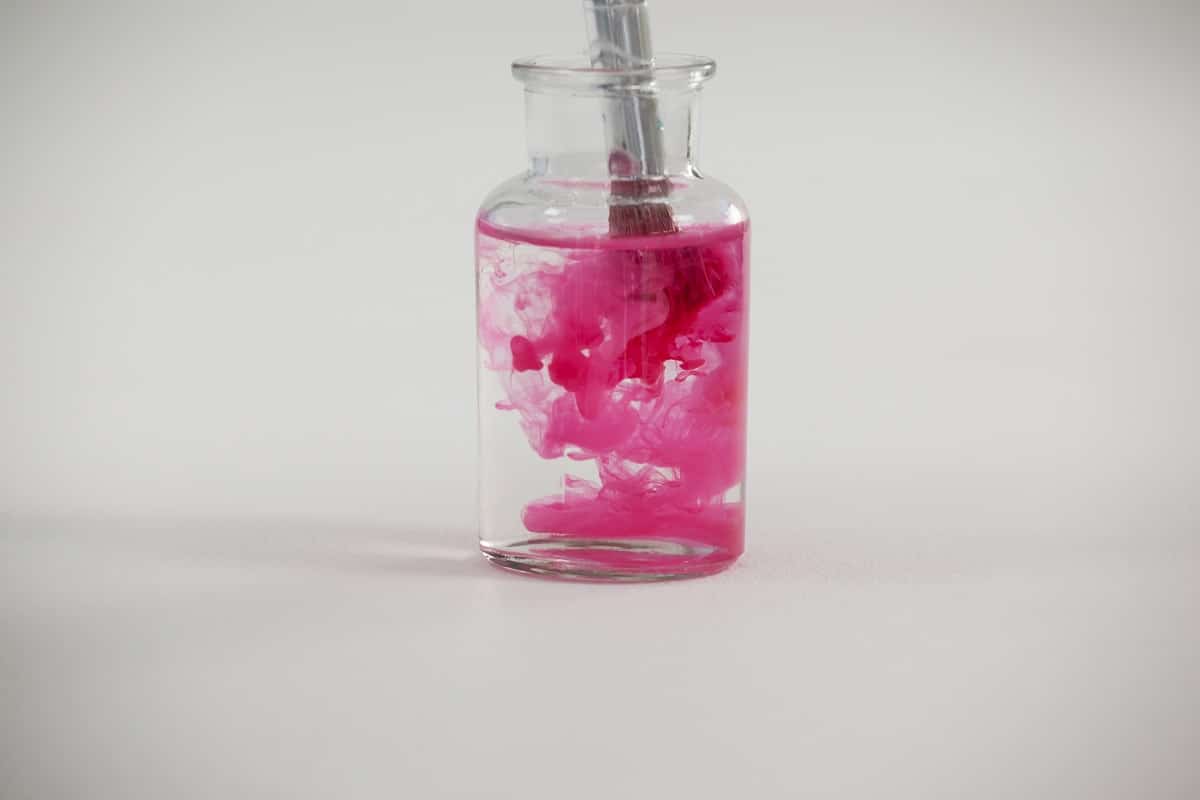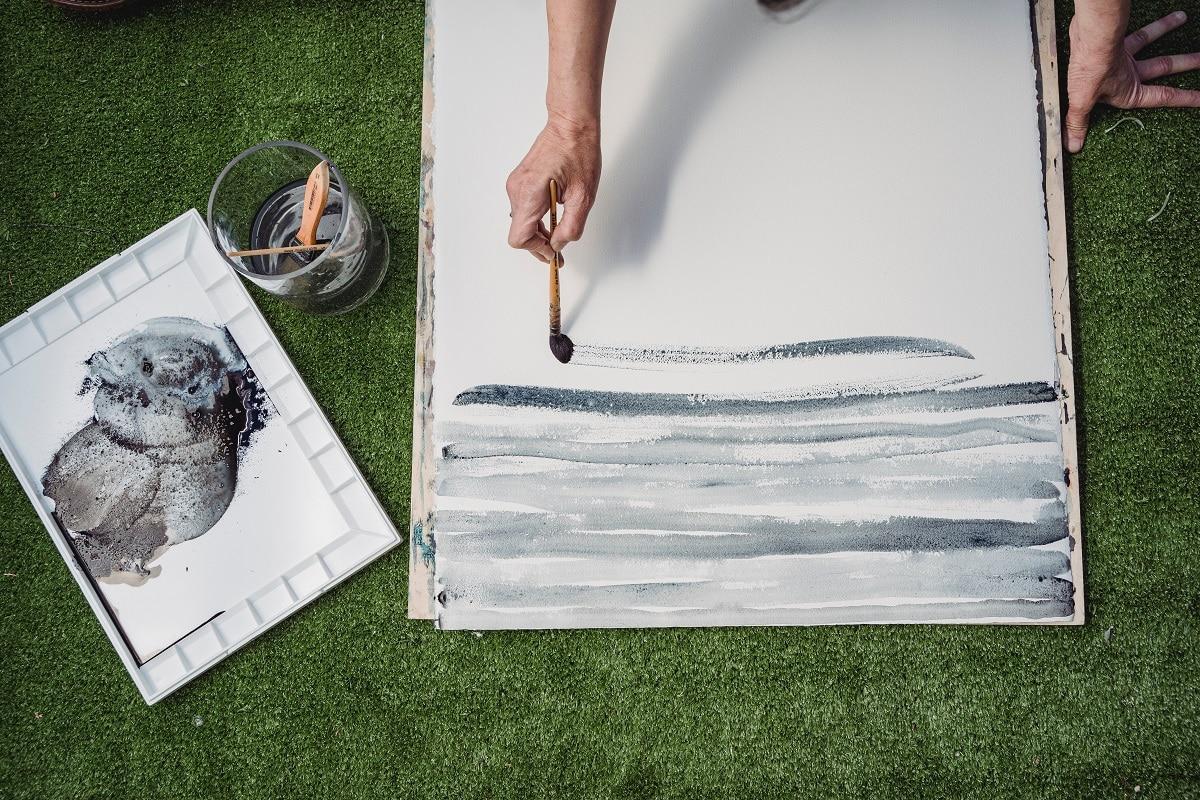Paint brushes typically look like a mess after finishing an artwork. But the best brushes for acrylic painting should be maintained well so that they can last a long time.
There are several ways to get that excess acrylic off your brushes. For example, using an acrylic brush cleaner fluid will have your painting tools primed and ready for use in a jiffy. But what if you don’t have access to the cleaner fluid?
So today, we will help you know how to clean acrylic paint brushes between colors and what to do if your brushes begin to dry while learning how to marble acrylic paint? Dive in!
Different Ways to Clean Acrylic Paint Brushes

You’ll find plenty of alternatives to clean acrylic paint brushes. The market is rife with these products, so you won’t face much trouble finding the right one.
You can find implements such as aluminum brush washers and paint pots to make the cleaning process much more effective. Mild soaps and lukewarm water can be used to achieve the same result as cleaner fluids.
1. Artist’s Paint Brush Cleaners and Soaps
Made specifically with brush longevity in mind, acrylic paint brush cleaners can come in solid soap bars or liquid form. The brush head needs to be dipped in the soap solution and swirled to clean the acrylic. Furthermore, these cleaners ensure that your paintbrush bristles do not lose their form or texture.
A typical brush cleaner will include nourishing oils and moisturizers for your brushes, keeping them in prime shape for a long time.
2. Using Ordinary Soap
You can use mild household soaps to clean out your acrylic paint brushes effectively, although their effectiveness may be limited when compared to cleaning fluids. These can be used while painting to prevent the acrylic from drying.
In this regard, it would be wise to refrain from using dish soaps, as they often contain aggressive agents that will cause the brush head to harden in the long run.
How to Clean Acrylic Brushes With Soap?
Here are the steps to cleanse your paint brushes with both brush cleaners and ordinary soaps.
What You’ll Need
Ideally, you should clean your brushes during or immediately after a painting session. For both these cases, you’ll need multiple jars of water to rinse them, a paper towel or a painter’s rag, and brush holders.
Step 1: Rub Out the Paint From the Brush
Use a paper towel or a painter’s rag to blot excess acrylic paint out of the brush. This will make the cleansing process easier and minimize the amount of color released as waste. It is essential to be gentle with the brush, or you may end up damaging it.
Since acrylic is a plastic-based emulsion, try to ensure that only a tiny quantity of it escapes into the water. The residue is not environmentally friendly, so it must be appropriately discarded.
Step 2: Swirl the Brush in Lukewarm Water
For the second step, you will have to shake the brush vigorously in lukewarm water to remove as much paint as possible. You may need to dab the brush onto a towel and redo the step a couple of times to ensure the acrylic left on your brush is minimal.
At the same time, it is vital to ensure that the water you use is not excessively hot, as it may cause lasting damage to your bristles. This is especially true in the case of synthetic brushes, which use polyester or nylon as a base.
Step 3: Clean the Brush in Soap Water
Rub the soap on the bristles until a thick lather builds up. Rinse in water, and repeat the process until the foam washes off the paint. The more foam you make, the less paint residue will remain. And once this is over, you’ll see no traces of acrylic paint left.
Step 4: Wash the Brush in Clean Water
After clearing the acrylic out of your paintbrush, pass the brush through clean water for the last time. If the brush has been washed properly, there will be little to no discoloration in the water. But there’s no harm in rinsing your acrylic brush multiple times just to be safe.
The process may seem tedious, but it will save you from discarding the brushes sooner than they need to.
Step 5: Dry the Brush
Finally, dab your brush on a clean rag gently and reshape the brush tip so it doesn’t lose shape while drying. Refrain from twisting it, as it will damage the bristles.
Once you’re done cleaning out all the paint from the brushes, you should keep them upright after they are dry. This will prevent them from losing form prematurely.
How to Clean Dried Acrylic Paint From Brushes?
Dried acrylic paint is notoriously difficult to remove from paintbrushes. Since acrylic is a plastic-based emulsion, it tends to form a solid plastic layer over the bristles. And although you can make a few last-minute attempts to salvage them, the brushes will no longer be in pristine condition. They will be stiffer and more difficult to use.
In the case of synthetic brushes, you may have no option but to get rid of them and purchase new ones. But fortunately, there are a few things that you can try to remove the dried acrylic from the bristles first.
Using Cleaning Fluids Made to Clean Dried Paint
You can submerge the tip of your brush bristles in cleaning fluids explicitly made to revive an unusable brush. Alternatively, you may use rubbing alcohol or ammonia to soak the strands and get rid of the dry acrylic paint.
Leave the brushes until the paint starts to come off the tip. It could be days before this happens, so patience is critical. Once it does, shake it around in the fluid until some residue comes off, and wash the rest off with warm soapy water. The brushes won’t return to the perfect working condition they were in before, but they will be limber and somewhat usable.
However, ensure that the fluid doesn’t touch anything but the bristles so that the handle and ferrule don’t get damaged. But should this method fail, you may have to buy new brushes.
Cleaning the Brush Ferrule and Handle
It can be quite tricky to clean out the ferrule of a brush. If paint dries here, the bristles will begin spreading apart near the ends and eventually split. But you can use water, rubbing alcohol, and a pointed instrument (such as a needle) to remove the paint.
Keep in mind that if the paint has dried completely, you may not be able to clean it off at all. So, it’s a good practice to not get paint on the ferrule at all.
As for cleaning the brush handle, you can use a scrubbing pad and rubbing alcohol to remove paint from the handle.
Alternatives to Store-bought Cleaning Fluids
When seeking alternatives to store-bought cleaning fluids, the best ones can easily be found at home. Here’s how you can use these common liquids as impromptu brush cleaners.
1. Vinegar
An excellent option for cleaning acrylic paint brushes, vinegar does its job spectacularly for both synthetic and natural brushes. Start by heating up vinegar until it boils and fill it up in a container.
Then, dip your brushes in it and allow them to soak for an hour. You should take care to not allow any fluid in the brush ferrule. Swirl the brushes in clean water until the paint comes off.
Finally, blot off the excess fluid using a paper towel or a piece of cloth.
2. Acetone
Acetone can clean brushes well, even if the paint on them has completely dried. Dry paint breaks down when the fluid runs through it and makes the bristles usable again.
To clean your paint brushes, soak your brushes in acetone for 15 minutes and swirl them around a few times before taking them out. Dab off the excess fluid (and paint) with a piece of cloth or paper towel.
The vital thing to note here is that acetone can damage the glue that holds the bristles to the ferrule. Hence, you must be careful while using it and remove any excess fluid with a rag.
3. Alcohol
Alcohol-based fluids can break down acrylic paint from brushes quite well. Liquids like hand sanitizers can be used as cleaning fluids when mixed in water. It’s important to note that they can harm the bristles and break down the ferrule glue, so clean your brushes with care.
A mixture of denatured alcohol and warm water can serve as a homemade acrylic brush cleaner as well. You can make it by mixing both fluids in equal parts.
Cleaning paint brushes with alcohol-based cleaners is fairly straightforward. You can rub a few drops of the fluid into the bristles using your hands and allow the fluid to perform its task. Once the liquid has worked its way into the brush, rinse the sanitizer off in soapy water.
4. Fabric Softener
If you’re struggling with dried brushes, then fabric softeners can come to your rescue. Alternatively, you can make some at home by mixing three parts of baking soda in two parts of warm water. The effectiveness of a fabric softener is not only limited to acrylic paint, making it a viable brush cleaner for all paints.
You can use a fabric softener solution to clean your paint brushes with the following steps.
Step 1:
Mix ½ cup of fabric softener into a gallon of water.
Step 2:
Soak your brushes in the softener solution for 10 seconds. Wait until the paint comes off your brushes.
Step 3:
Gently swirl the brushes so that the excess paint comes off. You may opt to use a soft scrub pad as well.
Step 4:
Dry the brushes off using a piece of cloth or paper towel.
Things to Remember While Cleaning Your Brushes

1. Use Soap in Limited Amounts
Ordinary soaps can have a drying effect on your acrylic brushes. To ensure the brush serves you for a long time, try to minimize the soap you use to clean acrylic paint out.
2. Your Brush Can Dry During a Painting Session
It’s essential to keep your brush wet while painting. If it dries, the acrylic paint will harden, leaving you with a brush in a less-than-ideal condition.
Remember to blot out any excess paint when switching to a different brush and rinse it in water.
3. Remember to Clean the Brushes Quickly
Acrylic paint dries quickly so it has a chance of rendering your brushes useless. So, cleaning your paintbrushes immediately after you’re done working on the artwork is a good idea. This will maintain their form for a long time and you won’t have to replace your brushes prematurely.
It’s said that prevention is the best remedy to any problem and so, not allowing your brushes to harden will pay dividends in the long run.
4. Do Not Keep Wet Brushes in an Upright Position
After you’ve cleared the acrylic paint out, keep the wet brush’s bristle-side down to dry. Keeping them upright while wet will allow moisture to seep into and damage the handle and ferrule. And ensure they are completely dry before storing them properly.
You can use washers to keep your brushes upright when drying them.
5. Never Touch the Paint on the Bristles With Bare Hands
Using your bare hands to rub out the paint can cause the paint to stick to your skin. While most colors have been tested for being non-toxic, it is always a good idea to keep foreign elements out of your body.
You can use gloves for this purpose or avoid touching the bristles while allowing the cleaning fluids to do all the work on your behalf.
6. Discard Waste Water Properly
Since acrylic is not water-soluble, you can allow the paint in your waste water to settle. The water can be poured out into the drain afterward and the remaining acrylic paint can be thrown into a trash can.
7. Never Leave Your Brush in the Water
A wet brush can cause damage to its ferrule and handle. The tip will lose shape, and the glue holding the brush together can come off, which will reduce the lifespan of your brush drastically.
Remembering this while learning how to marble acrylic paint is also essential, since water is a core component of the marbling process.
8. Cleaning Fluids Like Paint Thinner Can Be Reused
When using cleaning fluids, acrylic paint will form a sediment at the bottom of the container. However, the remaining fluid can be transferred into another vessel for reuse.
9. Dip Only the Tip of Your Brush in the Paint
Acrylic is a stubborn substance to clean out of brushes. And when stuck near the ferrule, it can be downright impossible to properly remove. Hence, it’s an excellent practice to submerge only the tip and rinse the brush between colors.
10. Trim Off the Ends of Damaged Brushes
If only the ends of your brush are damaged, you can opt to trim a small part of the bristles off. You must be careful while doing so, as trimming off too much may make the brush unusable.
If the brush can’t function well even after cutting the ends off, you’ll need to replace it.
11. Condition the Brushes
You can also prolong the life of your brush bristles by using conditioners made specifically for the purpose of the usual hair conditioners at home.
How to Clean Acrylic Paint Brushes Frequently Asked Questions?
How can you store paintbrushes properly after cleaning?
Once dried properly, you can store your brushes in cases or paint brush washers. Also, avoid putting any undue pressure or weight on them so that they do not deform.
Are synthetic brushes easier to clean than natural hair brushes?
The glue holding the bristles and ferrule of synthetic brushes has the risk of breaking down or dissolving when using cleaning fluids. Since they are made from materials like polyester and nylon, the acrylic paint may end up sticking to the bristles.
On the other hand, natural brushes are sturdy and resistant to cleaners like rubbing alcohol. They last for a long time and cause minimal trouble while cleaning.
How can you clean oil paint out of the brushes?
The process of cleaning oil paints is similar to cleaning their acrylic counterparts. All you need to do is use mild soaps or cleansing agents, rinse the brushes, dry, and then store them.

How to Clean Acrylic Paint Brushes Conclusion
Caring for your painting implements can pay dividends in the long run. So, you can continue to create and explore the boundaries of your imagination, armed with paint brushes that are reliable and consistent. All you need to do is maintain a cleaning routine and you’re good to go.
But that’s not all. You can get creative with a paintbrush that looks apparently useless and experiment with texture creation. Sure, the painting experience may not be consistent, and the resulting brush strokes can cause unwanted splotches, but that is kind of part of the fun. With paintbrushes old and new, your painting styles will become more varied and interesting.
You will need a new brush regardless, but experimentation may have you discover new ways of painting!
You getting fed up with what printing option you should choose to do a print job, laser or inkjet. Fear not, we have an excellent article for you to look into before choosing the right printer for your job. Check out our article on why laser printer is better than inkjet printers to know more on this subject.


